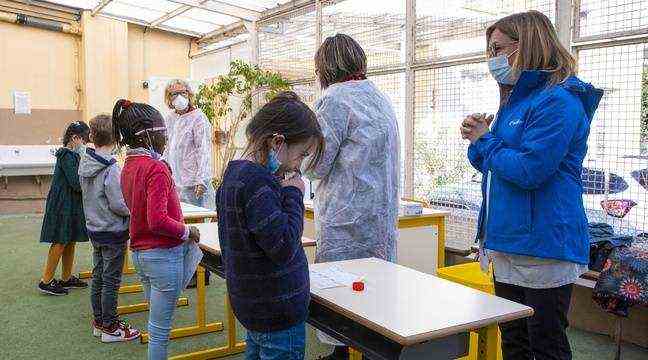Soon the end of the galley for the parents of schoolchildren in Val d’Oise? This weekend, the Ministry of National Education indicated that this Ile-de-France department was one of the ten selected in France * to experiment with a new health protocol. In a few days – its entry into force is still unknown – the detection of a student positive for Covid-19 will no longer automatically result in the closure of the class for seven days. Instead, his classmates will be offered a saliva test and only those who test positive or refuse to submit to it will have to isolate themselves, the others can continue to go to school normally.
This experiment announced by Jean-Michel Blanquer last Tuesday echoes the recommendations of the Scientific Council. In an opinion delivered on September 13, the advisory body recommended to carry out weekly tests in primary schools in order “to send home only children detected positive and not all students in the same class”, considering that the The benefits of such a method were both “sanitary” and “educational”, with fewer school days lost. “Basically, we are in favor of all measures that allow children to go to class, but was a new protocol really necessary? The others would have worked well if we had put in the means ”, reacts Philippe Renou, co-president of the FCPE of Val d’Oise.
A representative department
The fact remains that for the moment, it is the vagueness that remains: when will the measure come into force? How long will the experiment last? Are all schools concerned or only some within the department? At the Ministry of Education, we are assured that arbitrations and adjustments are still underway and that details will be given later this week. The only certainty: if parents refuse to have their children tested, as is their right, they will automatically be considered positive cases. An announcement that puzzles Philippe Renou. “This double talk annoys us, on the one hand, we leave parents free to make their own choices, but on the other hand we penalize them if they do not make the ‘right decision’. “
Even the choice of Val d’Oise to integrate the experimentation is intriguing. Currently, according to the Ile-de-France Regional Health Agency, 42 classes are closed in nursery and primary schools in Val d’Oise, against 97 just two weeks ago. If the epidemic situation has improved markedly since mid-August, this department in the outer suburbs of Paris nevertheless remains the one which, among the ten selected, has the highest incidence rate: 65 cases on average per week per 100,000 inhabitants, slightly more than the national average. And if we look at the age group of 6-10 years, which constitutes the bulk of children in primary school, this rate even reaches 93 cases per 100,000 inhabitants. That is three times more than in Manche or Aisne, also selected to experiment with this protocol.
A territory representative of the French population
In fact, according to our information, if the Val d’Oise was selected to be part of the experiment, it is not so much because of its epidemic situation as of its population. “It is a fairly representative territory of the population with certain popular areas, others much more bourgeois, which is important in the context of an experiment”, specifies a health source.
The figures for the epidemic are, in many respects, almost identical to those of the national average. Another decisive criterion: the offer which should make it possible to absorb a consequent increase in the number of regular tests. It remains to be seen whether the experiment will be conclusive.
* The other departments selected for the experiment are Aisne, Ariège, Côte-d’Or, Landes, Manche, Morbihan, Moselle, Rhône and Var.

